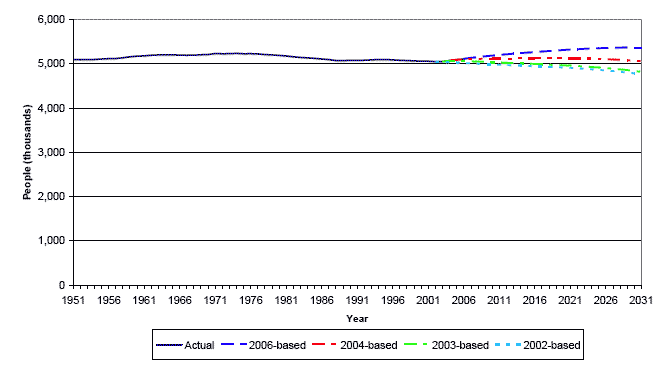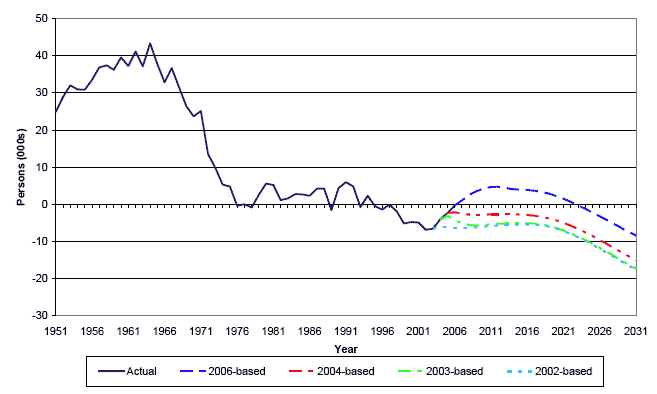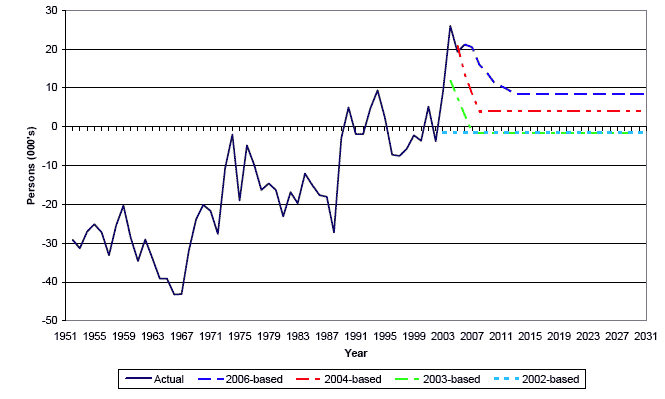
4.1 The last set of projections were based on the mid-year population estimates for 2004. Before this an interim set of projections, using 2003 as the base year, were produced and before this the previous full set of projections were based on the 2002 mid-year population estimate. The key changes from previously published projections in terms of births, deaths and total population are shown in Table 5a, Table 5b and Table 5c respectively. Section 4.4 looks at the differences in the migration assumptions between the projections. Note that national projections are usually produced every two years – the next set will be 2008-based and are due to be published in October 2009.
4.2 Figure 6 compares the 2006-based projection with previous projections. It shows that the level of the population under the latest projection is higher than for earlier projections and that the population is now projected to rise until the early 2030s before declining. Earlier projections showed the population decline occurring earlier.
Figure 6 Actual and Projected total population with previous projections, 1951-2031

4.3 The difference between the projections is due in part to the higher starting point of the 2006 mid year estimates and in part to the different assumptions made about fertility, mortality and migration. The natural change (the difference between the number of births and deaths) for the 2006-based projection compared with previous projections is shown in Figure 7. The number of births is projected to be higher (by an average of almost 4,300 in the first 25 years of the projection) and the number of deaths lower (by an average of over 2,200, again during the first 25 years) in comparison to the 2004-based projections. As a result the natural change is ‘higher’ throughout the projections with a natural increase between 2007 and 2021 and a reduced natural decrease thereafter. More information on the reasons for the differences is given in Section 3 and Annex A, Annex B and Annex C.
Figure 7 Actual and Projected Natural Change (Births minus Deaths) with previous projections, 1951-2031

4.4 The overall-long term migration assumption has been increased from the assumption used in previous projections as Figure 8 demonstrates. Compared to the 2004-based projections Scotland’s long-term migration assumption has risen from +4,000 to +8,500. This long term assumption now takes effect after 6 years rather than after 3 years as in the 2004-based assumptions.
Figure 8 Actual and Projected Migration with previous projections, 1951-2031

4.5 This increase in the assumption for the 2006-based projections compared to earlier sets is partly because they are trend based and relatively large numbers of people migrated to Scotland from the rest of the UK and overseas in the last two years. The increase is also partly due to a change in the methodology used by ONS to allocate international migrants to the constituent countries of the UK. More information on this change in methodology can be found on the ONS website at:
4.6 The tables below summarise the differences between the current 2006 and the 2004-based projections. The difference in results for the projected age structure of Scotland is small, but the 2006-based projections show a slightly smaller percentage of the population to be of pensionable age and slightly higher percentages to be children or of working in 2031. As a result the projected number of dependents per 100 of working age is lower in 2031 in the 2006-based projections than in the 2004-based projections.
Projected age structure of Scotland’s population (percentage of total population)
Age Group1 |
2004-based |
2006-based |
||
|---|---|---|---|---|
2006 |
2031 |
2006 |
2031 |
|
Children |
18.0% |
15.7% |
18.0% |
16.0% |
Working age |
62.7% |
59.9% |
62.8% |
60.0% |
Pension age |
19.3% |
24.4% |
19.2% |
24.0% |
Projected number of dependents per 100 population of working age, Scotland
Age Group1 |
2004-based |
2006-based |
||
|---|---|---|---|---|
2006 |
2031 |
2006 |
2031 |
|
Children |
28.7 |
26.1 |
28.7 |
26.6 |
Pensioners |
30.7 |
40.8 |
30.6 |
39.9 |
All dependants |
59.4 |
66.9 |
59.3 |
66.5 |